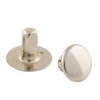SciFiPropFreak
Active Member
Starting in 2007, I went on an adventure of building Nazgul gloves for me and some friends.
I this tread I will try to show how I did it, what I did wrong, how problems were solved and methods refined, etc.
If you want to look at the pictures and a little discription, only, you may have a look at my Album on Facebook.
I will build up the documentation simultaneously here and on FB over the next days and weeks, but I will give more detailed description in this thread + respond to your questions
These are my most recent gauntlets, build for HobbitCon2014

And here is a comparison between my first version and the most recent one.

Materials are fibreglass, resin, leather and some other stuff, which I will explain for each task.
I hope you will enjoy this documentation!
EDIT: currently making some of these again, check out the LTDRUN-Thread if interested
I this tread I will try to show how I did it, what I did wrong, how problems were solved and methods refined, etc.
If you want to look at the pictures and a little discription, only, you may have a look at my Album on Facebook.
I will build up the documentation simultaneously here and on FB over the next days and weeks, but I will give more detailed description in this thread + respond to your questions
These are my most recent gauntlets, build for HobbitCon2014

And here is a comparison between my first version and the most recent one.
Materials are fibreglass, resin, leather and some other stuff, which I will explain for each task.
I hope you will enjoy this documentation!
EDIT: currently making some of these again, check out the LTDRUN-Thread if interested
Last edited:





















